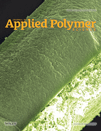Preparation and catalytic use of platinum in magnetic core/shell nanocomposites
Abstract
Platinum (Pt) nanoparticles show high activity as catalysts in various chemical reactions. The control of the morphology of Pt nanostructures can provide an opportunity to improve their catalytic properties. The preparation of Pt-loaded iron-oxide polyvinylbenzyl chloride nanocomposites was done in several stages: first by the formation of the core consisting of magnetite nanoparticles and second by the polymerization of vinylbenzyl chloride in the presence of the magnetic core particles. The third step is the amination of the chlorine group with ammonia, which leads to an ion exchange resin. Then, the Pt precursor (H2PtCl6) is attached by ion exchange. Finally, the Pt ions are reduced to Pt metal with NaBH4. The obtained material can be dispersed easily and be used as a catalyst which can be separated after the reaction by magnetic fields. Characterization of the resulting metallic nanocomposites is evaluated by atomic absorption spectroscopy, thermal gravimetric analysis, transmission electron microscopy, infrared spectroscopy, and gas chromatography. The activity of Pt at magnetic core/shell nanocomposites was measured for the reduction reaction of cinnamaldehyde to cinnamyl alcohol. © 2012 Wiley Periodicals, Inc. J. Appl. Polym. Sci., 2013




